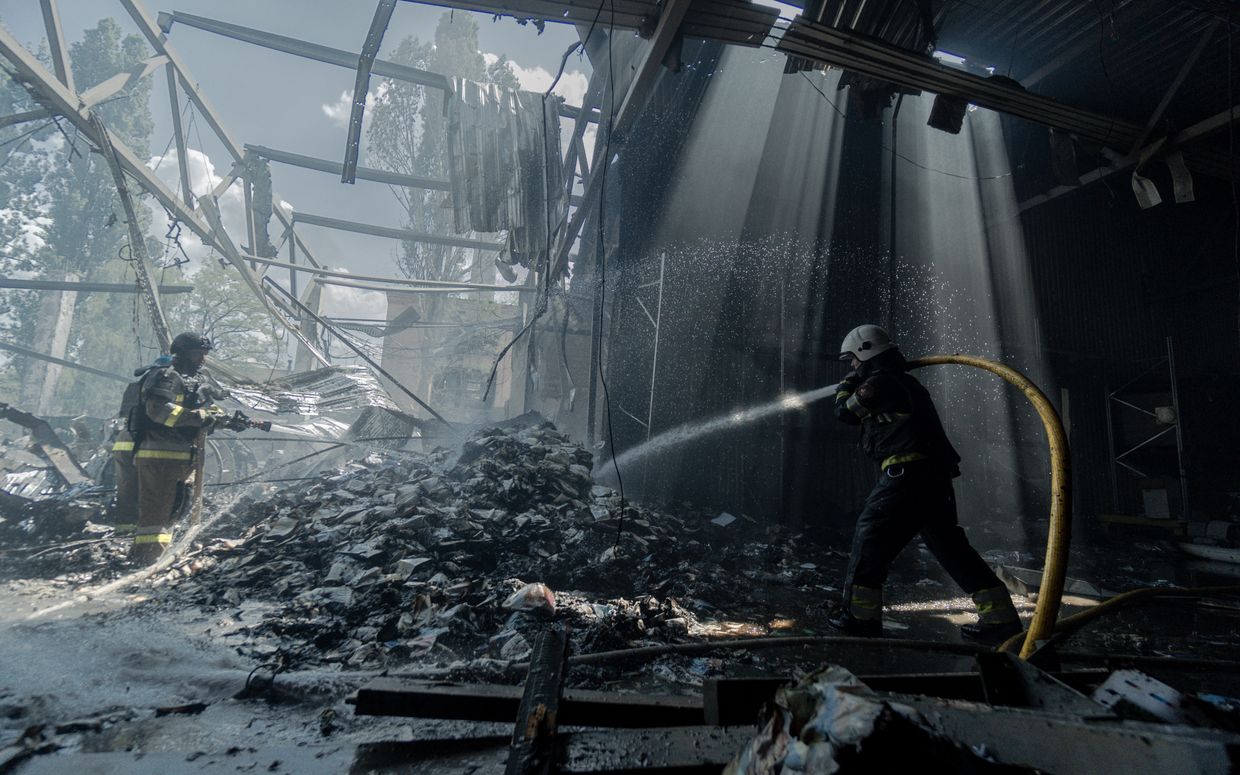Editor’s Note: This is issue 134 of Ukrainian State-Owned Enterprises Weekly, covering events from May 25 – June 1, 2024. The Kyiv Independent is reposting it with permission.
Energy sector
Ukrainian energy facilities struck again. In the early morning of June 1, Russia attacked Ukraine’s energy infrastructure in Zaporizhzhia, Dnipro, Donetsk, Kirovohrad, and Ivano-Frankivsk oblasts, the Ukrainian Energy Ministry reported. This is Russia’s sixth massive drone strike on energy facilities since March 22, the ministry said.
Because of the attack, Ukrenergo had to impose additional electricity rationing for June 1 2024.
Rinat Akhmetov’s DTEK, Ukraine’s largest private energy holding, reported that Russia attacked two of its thermal power plants (TPPs) again, severely damaging equipment. This is the sixth massive attack on its TPPs in two and a half months, DTEK said.
Later, Ukrhydroenergo reported that Russian attacks had caused critical damage to two of its hydroelectric power plants (HPPs). The company has a total of ten HPPs.
After the attack in Zaporizhzhia, traffic was blocked through the Dnipro HPP. After a detailed examination of the consequences, the authorities closed the dam for traffic over the weekend.

On June 6, 2023, Ukrhydroenergo reported that the Kakhovka HPP was destroyed beyond restoration after the Russians set off a massive explosion in the engine room. See our Issue 91 for more detail.
Russian missiles attacked Ukraine’s largest HPP, the Dnipro HPP in Zaporizhzhia, on March 22. See Issue 124 for more detail.
During another missile attack, on March 29, the Kaniv and Dniester HPPs were deliberately targeted by Russian forces. See Issue 125 for more detail.
Since March 22, Ukraine has faced six massive missile and drone strikes on energy facilities, including the above attack on June 1. See Issues 124, 125, 127, 129, and 131 for detail on the earlier attacks.
After every Russian mass missile attack on Ukraine’s vital infrastructure, emergency outages take place, lasting for days due to the ongoing repair works. During such outages, people in Ukraine are often left without electricity, heating, water supply, or access to mobile phone networks.
Ukrenergo reinstates scheduled power outages for households and industry in all regions. On May 31, Ukrenergo announced that it was bringing back planned restrictions on electricity consumption. This is due to significant shortages in Ukraine’s power system caused by Russian strikes.
In addition, power plants undergo scheduled maintenance in spring and summer, which can also affect shortages in the power system. This maintenance is legally required: It takes place on an annual basis and cannot be cancelled or postponed. It is necessary to prepare power units for operation under high load during the next heating season, the company explained.
Ukrenergo announced possible outages during evening peak hours on June 1. Later, due to the morning attack on June 1, the company added another hour of possible outages.
On May 14, Ukrenergo started controlled emergency power outages for industrial and household consumers in all regions of Ukraine during evening peak hours. The power supply to critical infrastructure facilities was not restricted, the company said. See our Issue 132 for more detail.

Two weeks later, Ukrenergo temporarily abandoned hourly outages as the repairs of two nuclear power units were completed. Ukrenergo’s CEO Volodymyr Kudrytskyi then explained that the absence of hourly power outages in the last days of May was a temporary improvement, and the situation would soon deteriorate again as certain units at nuclear power plants would be repaired.
The Cabinet increases the electricity tariff for households by 64%. On May 31, the Cabinet of Ministers adopted a resolution setting a single electricity tariff for households at Hr 4.32 ($0.11) per kWh. The new tariff would be effective from June 1 until the end of April 2025.
Tariffs have also changed for individual and collective household consumers in residential buildings equipped with electric heating installations. Households consuming up to 2,000 kWh per month will pay UAH 2.64 per kWh; those consuming more, Hr 4.32 per kWh.
According to the Energy Ministry, the “night tariff” will be Hr 2.16 per kWh.
Energy Minister Herman Halushchenko named the tariff increase “a difficult but necessary step” that is needed to restore Ukraine’s energy infrastructure. If Russia had not systematically destroyed it, tariffs would have remained unchanged so far, he added.
Given the difficult economic situation caused by the full-scale war, it is impossible to let the electricity price for households rise to market levels (almost Hr 7.5 per kWh), but the state cannot maintain an extremely low preferential price for all consumers. Those who cannot afford to pay for electricity at the new tariff would receive targeted subsidies, Halushchenko added.
For an average household consuming 170 kWh a month, the monthly electricity bill will increase by Hr 285, the Energy Ministry summed up.
According to EP, official communications cite the need to restore energy infrastructure as the key reason for the household tariff increase. In reality, Energoatom and Ukrhydroenergo will be the key beneficiaries of this change. It will help these two state-owned companies avoid about Hr 86.6 billion ($2.1 billion) per year in PSO costs, Oleksandr Vizir, head of Association of Energy Efficiency and Energy Saving, wrote for EP.

Fortunately, Energoatom’s assets have not been targeted by Russian shelling. The company is likely to use the money for the construction of nuclear units, the expediency of which raises many questions, EP also wrote.
In contrast, Ukrhydroenergo’s facilities were among the key targets of Russian shelling (see our Issues 91, 124, and 125 for more detail), so the additional funds would likely be used to restore the hydroelectric power plants.
Energoatom and Ukrhydroenergo were granted the right to sell electricity on market terms from Oct.1, 2021. Under the new PSO model, the proceeds were used to compensate electricity providers for the difference between the regulated household tariffs (at that time, Hr 1.44/kWh and Hr 1.68/kWh depending on the volume of consumption) and market prices.
Since October 2021, the Cabinet of Ministers has repeatedly extended the PSO mechanism to keep electricity tariffs for households unchanged until the end of the previous heating season. The PSO mechanism was in place until April 30.
On May 30, 2023, the Cabinet approved an increase in the electricity tariff for households to Hr 2.64/kWh from June 1, 2023.
As we reported in Issue 115, in January 2024, the PSO model had been extended until April 30. Later, it was extended for another month, from April 30-May 31. See Issue 131 for more detail.
At the same time, regardless of the size of the household tariff, scheduled power outages would continue for two or three years, depending on how quickly Ukraine can restore the ruined infrastructure, Oleksandr Kharchenko, director of the Energy Research Center, told EP.

The electricity prices for businesses will also increase from June 1, due to the revision of price caps by the National Energy and Utilities Regulatory Commission (NEURC). The monthly index for base-load electricity on the Ukrainian Energy Exchange was Hr 3.304 per MWh (excluding VAT) in May 2024, but it rose to as much as Hr 5.541 per MWh in June 2024, EP added.
As we reported in our earlier issues, the low electricity tariff has consistently caused financial challenges for Ukrainian energy SOEs:
- Electricity market had a chain of debts of “everyone to everyone” worth Hr 60 billion ($1.5 billion. See Issue 110 for detail.
- After accumulating large debts due to losing the Zaporizhzhia Nuclear Power Plant, Energoatom had only been able to fulfill all PSOs again since September 2023 (see Issue 109). The company paid Hr 1.8 billion ($45 million) it owed to Ukrenergo for dispatch control services in November 2023 (see Issue 113) and reported in January that it had fully fulfilled its PSO obligations for 2023 (see Issue 115).
- Ukrhydroenergo finished paying for all household PSOs for 2023, the company said in late January. See Issue 116 for more detail.
- Energoatom fully paid Hr 48.5 billion ($1.2 billion) for household PSO costs for January-April 2024.
As we wrote in April, Naftogaz left the current gas tariff for households unchanged for at least another year. See Issue 129 for detail.
Privatization
SPFU’s first attempt to sell the confiscated PentoPack Plant fails. According to Prozorro.Sale, the privatization of PentoPack failed, as no participants registered for the auction. The plant had been confiscated from sanctioned Russian-Greek businessman Ivan Savvidi.
The State Property Fund of Ukraine (SPFU) had scheduled the auction for May 31, with a starting price of Hr 203 million ($5 million).
The second attempt to sell the plant is scheduled for June 10, with the starting price halved to Hr 102 million ($2.5 million).
The SPFU declared its privatization plans for PentoPack in early March 2024 (see our Issue 122) and approved its starting price at Hr 203 million ($5 million) in early May (see Issue 131).

According to the SPFU, PentoPack is one of the leading producers of packaging for meats and sausages. It produces multilayer synthetic shrink wrap using modern technologies, including printing with UV, water, and alcohol inks.
PentoPack’s products are used in more than thirty countries around the world. In Ukraine, the company does business with Rud, Globino, and Myasna Gildiya.
PentoPack retained 193 jobs and has no wage or state budget arrears. The company plans to enter new markets for packaging materials for the dairy industry, fish processing, and animal feed packaging, the SPFU added.
Sanctioned AEROC is now ready for privatization, the SPFU’s head Vitaliy Koval said on May 27.
According to Koval, the SPFU has had all seizures of the concrete plant’s corporate rights lifted. AEROC was previously owned by sanctioned Russian oligarch Andrei Molchanov.
In SOE Weekly Issue 97, we wrote that the Ministry filed a lawsuit with the High Anti-Corruption Court (HACC) to seize Molchanov’s assets in early July 2023.
As we reported in Issue 100, the HACC ruled to seize these assets in late August 2023.
In Issue 106, we reported that in October 2023, the HACC’s Appeals Chamber confirmed the legality of the decision to seize AEROC.
As we wrote in Issue 110, on Nov. 7, 2023, the SPFU announced that it took over the company on Nov. 2 2023 after it was seized from Molchanov’s LSR Group. It is on the list of large-scale assets to be privatized in 2024.
According to the SPFU, AEROC makes aerated concrete blocks in Obukhiv and Berezan, though all production stopped in July 2022. Another plant is under construction in Stryi (Lviv Oblast).
Ukrainian SOE Weekly is an independent weekly digest based on a compilation of the most important news related to state-owned enterprises (SOEs) and state-owned banks in Ukraine.
The contents of this publication are the sole responsibility of the editorial team of the Ukrainian SOE Weekly.
The SOE Weekly is produced and financed by Andriy Boytsun. Communications support is provided and financed by CFC Big Ideas. The SOE Weekly is not financed or influenced by any external party.
Editorial team: Andriy Boytsun, Oleksiy Pavlysh, Dmytro Yablonovskyi, and Oleksandr Lysenko.















